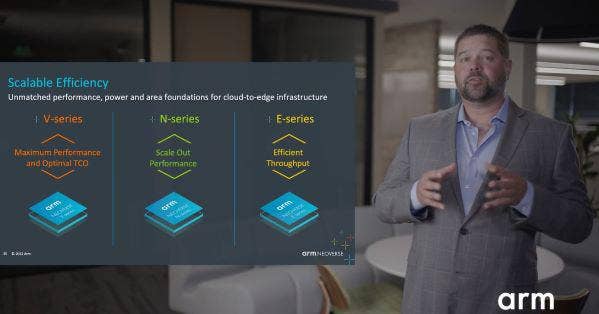Arm’s Neoverse V2 Platform Targets Cloud, Hyperscale, HPC
British semiconductor and software design company Arm plans to launch an updated version of its Neoverse in 2023.

Arm’s Christopher Bergey
Arm, the British semiconductor and software design company, said Wednesday that its updated Neoverse processor cores in 2023 will outperform its first version in per-thread performance for cloud, hyperscale and high-performance computing (HPC) workloads.
In response to customer demand to further push cloud workload performance without requiring more power and area, Senior Vice President and General Manager Christopher Bergey said the company developed Neoverse V2 platform, code-named “Demeter.”
It features Arm’s newest V-series core and the Arm Neoverse CMN-700 mesh interconnect, a high bandwidth, low-latency system that supports many applications, includes networking infrastructure, storage, server, HPC, automotive, and industrial solutions.
[Related: Lenovo ThinkPad X13s Review: A Top Arm-based Windows PC]
Arm also said that Santa Clara, Calif.-based chip giant Nvidia already is using V2 technology as the “compute foundation” for its Grace data center CPU. Nvidia terminated its $40 billion deal to buy Arm earlier this year.
In a presentation, Bergey outlined the company’s strategy for Neoverse, a group of 64-bit processor cores licensed to OEMs by Arm. They are intended for data center, edge computing, and high-performance computing use.
“Arm is now in every major public cloud across the globe: AWS, Microsoft, Google, Alibaba, Oracle, the biggest names in technology,” Bergey said. “This means every developer in the world now has access to Arm…Neoverse is everywhere in the 5G RAN (radio access network).”
As part of Arm’s Neoverse roadmap, improvements have been built on delivering the performance efficiency and specialized processing that the infrastructure market needs, he said.
“Make no mistake, the uniqueness of Arm’s business model, our global team of world-class engineers, and the diversity of our partner ecosystem have put Arm in a position to lead the next generation of infrastructure,” he said.
Jered Floyd, Red Hat’s technology strategist, said the way that Arm fosters an open ecosystem means hardware vendors can select components that might be most appropriate for a given use case or a given industry.
“But they’re also able to bring standards so that it’s possible to support a multitude of devices in upstream way, in a standards way,” he said during the presentation.
Paul Nash, vice president of product, Azure Compute Platform at Microsoft, said he is excited about the company’s first generation of Azure virtual machines (VMs) powered by Arm-based processors.
“We’ve had a lot of interest since we began previewing these VMs,” he said during the recorded presentation. “And we’re really looking forward to their general availability and in turn helping customers bring their latest innovation to market.”
Michael Clegg, vice president and general manager of IT solutions provider Supermicro, said V2 offers good performance relative to price as well as a lower use of power.
“We will be able to increase our offering as well as a number of our partners have integrated inside them,” he said during the pre-recorded forum.
Mark Shuttleworth, CEO of Canonical, the company that developed the Ubuntu operating system, said the nature of data center consumption has been profoundly transformed by the public cloud.
“The emergence of Arm as an architecture on the public cloud means that every enterprise in the world now can explore the benefits of a different architecture for their workloads,” he said during the session. “I think that … will drive innovation at the architecture level into the data center into the enterprise.”